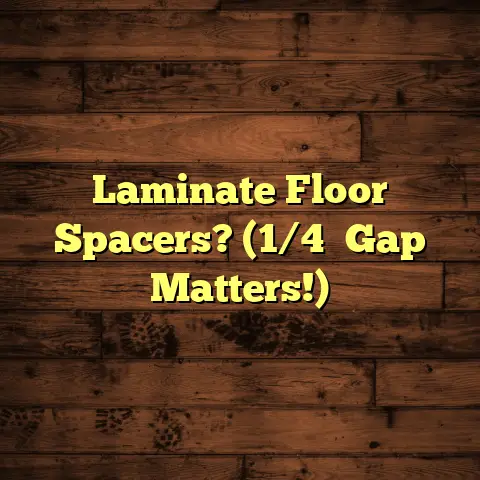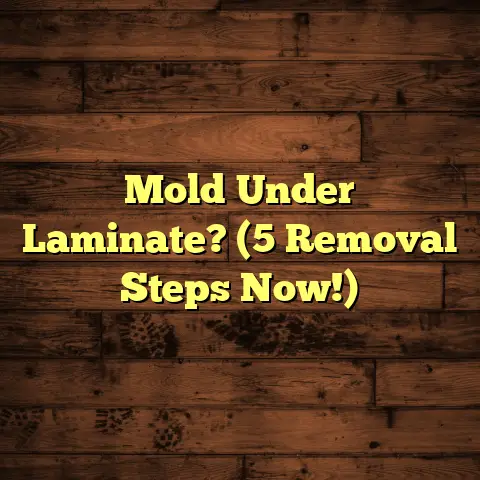Hardwood Underlayment Needed? (2 Reasons Why!)
I’m Mike, your friendly neighborhood flooring contractor.
And let me tell you, I’ve seen it all when it comes to hardwood floors.
From stunning installations to absolute disasters, and one thing I’ve learned is this:
Skipping the underlayment is a recipe for trouble.
Imagine this: you’ve just invested a fortune in gorgeous hardwood. It looks amazing!
But soon, every footstep echoes through your house, and you start noticing slight warps and buckles.
The culprit? You guessed it – lack of proper underlayment.
According to the National Wood Flooring Association (NWFA), moisture-related issues are a leading cause of hardwood flooring failure.
And trust me, those repairs aren’t cheap!
Choosing the right underlayment is like giving your hardwood floor a solid foundation, a shield against the elements, and a muffler for noise.
It’s not just an extra step; it’s an investment in your home’s comfort, value, and longevity.
So, let’s dive into why underlayment is essential, and how it can save you from costly headaches down the road.
Understanding Hardwood Flooring and Underlayment
Okay, let’s start with the basics.
What exactly is hardwood flooring?
Well, it’s pretty much what it sounds like: flooring made from solid wood planks.
We’ve got solid hardwood, milled from a single piece of wood, and engineered hardwood, which is made of layers of plywood with a hardwood veneer on top.
Both are beautiful, but they react differently to moisture and temperature changes.
Now, what about underlayment? Think of it as a cushion or a barrier that sits between your subfloor (usually concrete or plywood) and your hardwood.
Its main job is to provide a smooth, even surface, absorb sound, and protect against moisture.
I’ve heard some homeowners say, “Underlayment? Nah, it’s just an extra expense.”
Or, “All underlayments are the same, right?”
Wrong!
Choosing the right underlayment is crucial for the performance and lifespan of your hardwood.
It’s not a one-size-fits-all situation.
Reason 1 – Sound Absorption and Noise Reduction
Let’s face it: hardwood floors can be noisy.
That beautiful, dense surface amplifies sound, turning every footstep into a mini-earthquake.
This is especially important if you live in an apartment, a condo, or a multi-story home.
Your downstairs neighbors (or even your own family members) will thank you for investing in sound absorption.
I remember one client, Sarah, who lived in a condo.
She installed gorgeous hardwood, but soon started getting complaints from her neighbor below.
Every time she walked, it sounded like a herd of elephants!
After I installed a sound-dampening underlayment, the complaints stopped. Problem solved!
According to a study by the Acoustical Society of America, a good underlayment can reduce impact noise by as much as 20 decibels.
That’s a significant difference!
So, how does it work?
Well, sound-absorbing underlayments are typically made of materials like foam, cork, or rubber.
These materials have tiny air pockets that trap and dissipate sound waves, preventing them from traveling through the floor and into the room below.
I’ve found that thicker underlayments generally provide better sound absorption, but it also depends on the material and density.
Here’s a quote from Tom, a flooring expert I know:
“Sound control is often overlooked, but it’s a game-changer.
A quality underlayment can transform a noisy house into a peaceful sanctuary.”
And I couldn’t agree more!
Reason 2 – Moisture Protection and Floor Longevity
Now, let’s talk about moisture – the silent killer of hardwood floors.
Even if you don’t live in a particularly humid climate, moisture can still seep up from the subfloor, especially if it’s concrete.
This moisture can cause your hardwood to warp, buckle, cup, and even develop mold and mildew. Yuck!
Underlayment acts as a moisture barrier, preventing water vapor from reaching your precious hardwood.
This is especially important in basements, kitchens, and bathrooms – areas prone to spills and humidity.
I’ve seen firsthand the devastating effects of moisture on hardwood.
One time, I had to replace an entire floor because the homeowner didn’t use a moisture barrier underlayment.
The floor was completely ruined by mold and rot. It was a costly and heartbreaking situation.
According to the Institute of Inspection, Cleaning and Restoration Certification (IICRC), water damage is one of the most common insurance claims for homeowners.
And flooring is often the first casualty.
There are several types of underlayment materials that offer moisture protection.
Foam underlayment is a popular choice, as it’s affordable and provides a decent level of moisture resistance.
Cork underlayment is another excellent option, as it’s naturally water-resistant and also provides sound insulation.
Rubber underlayment is the most expensive, but it offers the best moisture protection and sound absorption.
In my experience, it’s worth the investment, especially in high-moisture areas.
Here’s what Lisa, another flooring expert, has to say:
“Moisture management is key to a long-lasting hardwood floor.
Don’t skimp on the underlayment; it’s your first line of defense against water damage.”
And she’s absolutely right.
The Long-Term Benefits of Investing in Underlayment
Okay, so we’ve talked about sound absorption and moisture protection.
But what are the overall benefits of investing in underlayment?
Well, let’s start with the cost.
Sure, underlayment adds to the initial cost of your flooring project.
But think of it as an insurance policy.
By protecting your hardwood from moisture and sound, you’re preventing costly repairs and replacements down the road.
I’ve seen homeowners save thousands of dollars by simply investing in a good quality underlayment.
Plus, underlayment enhances the comfort of your home.
It provides a softer, more cushioned feel underfoot, making your floors more enjoyable to walk on.
It also reduces noise, creating a more peaceful and relaxing environment.
And let’s not forget about property value.
A well-maintained hardwood floor with proper underlayment can significantly increase the value of your home.
Potential buyers will appreciate the attention to detail and the long-term durability of your floors.
I remember one homeowner, John, who decided to skip the underlayment to save money.
A few years later, his floors started to buckle and warp.
He had to replace the entire floor, costing him thousands of dollars.
He told me, “I wish I had listened to you and invested in the underlayment. It would have saved me so much money and hassle.”
Don’t be like John.
Learn from his mistake and make the smart choice.
Investing in underlayment is not just about protecting your floors; it’s about protecting your investment, your comfort, and your peace of mind.
Conclusion
So, there you have it.
Two compelling reasons why hardwood underlayment is a must: sound absorption and moisture protection.
Skipping the underlayment is like building a house on sand.
It might look good at first, but it won’t last.
Investing in a quality underlayment is not just a matter of preference; it’s a necessity for anyone who wants to preserve their hardwood floors and enhance their home’s comfort and value.
Don’t wait until it’s too late.
Take action now to protect your investment and avoid potential pitfalls in your flooring project.
Talk to your flooring contractor, do your research, and choose the right underlayment for your needs.
Your floors (and your ears) will thank you for it!
And as always, if you have any questions, don’t hesitate to reach out.
I’m here to help you make the best decisions for your home.





